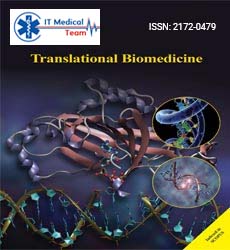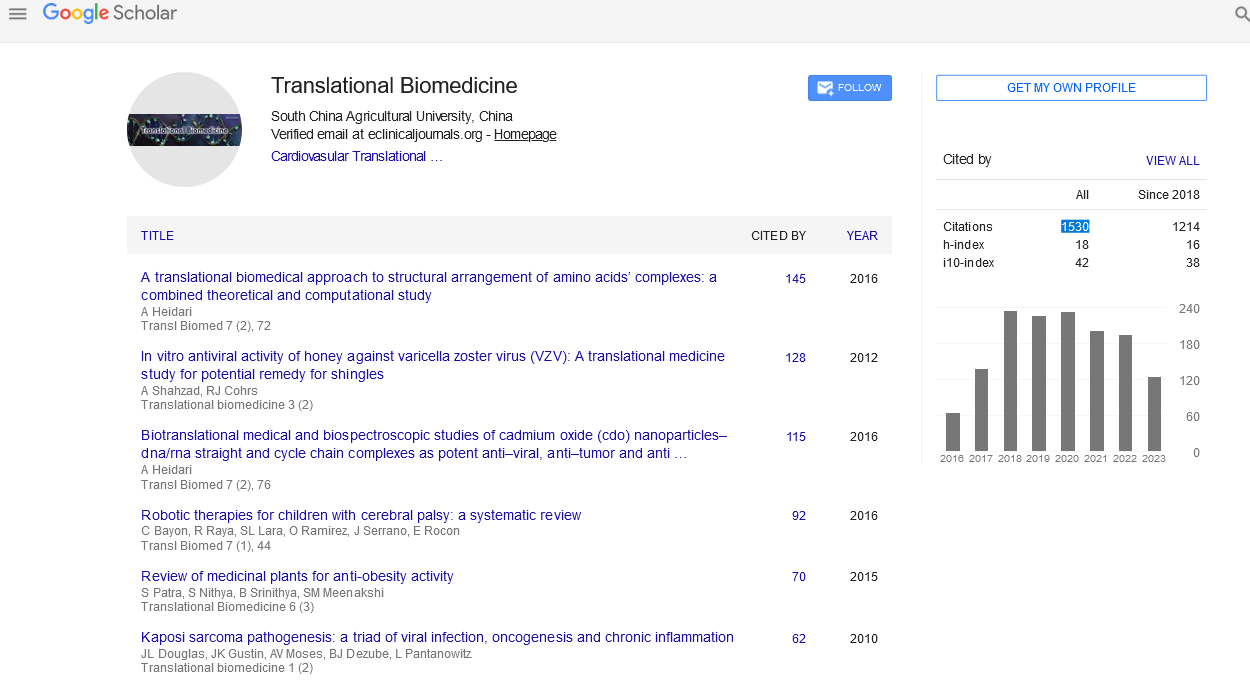Case Report - (2023) Volume 14, Issue 4
The Crucial Role of Preclinical Research in Advancing Medical Breakthroughs
Roddy smith*
Department of Preclinical Research, Bhutan
*Correspondence:
Roddy smith, Department of Preclinical Research,
Bhutan,
Email:
Received: 01-Jul-2023, Manuscript No. iptb-23-13870;
Editor assigned: 05-Jul-2023, Pre QC No. iptb-23-13870(PQ);
Reviewed: 21-Jul-2023, QC No. iptb-23-13870;
Revised: 25-Jul-2023, Manuscript No. iptb-23-13870(R);
Published:
31-Jul-2023
Abstract
Preclinical research plays a pivotal role in advancing medical breakthroughs by serving as the initial phase of drug discovery and development. This article highlights the significance of preclinical research in evaluating the safety, efficacy, and mechanism of action of potential therapeutics before they progress to human clinical trials. It examines the importance of safety and toxicity assessment, pharmacokinetics and pharmacodynamics studies, proof of concept experiments, regulatory compliance, and bridging the gap between laboratory discoveries and clinical applications. Preclinical research acts as a crucial foundation for scientific advancements, minimizing risks, and improving patient outcomes. By providing essential data and insights, preclinical studies accelerate the development of novel therapies and pave the way for ground-breaking medical innovations.
Keywords
Preclinical research; Drug discovery; Drug development;
Safety assessment; Toxicity evaluation; Pharmacokinetics;
Pharmacodynamics; Proof of concept; Regulatory compliance
INTRODUCTION
Preclinical research plays a vital and indispensable role
in the advancement of medical breakthroughs. It serves
as the critical foundation for the development and
progression of potential treatments before they are tested
on human subjects in clinical trials [1]. This article aims
to explore the significant role of preclinical research and
its contributions to scientific advancements and improved
patient outcomes. Before a new drug or therapy can be
introduced to the market and made available to patients,
it must undergo rigorous evaluation and testing. Preclinical
research is the initial phase of this process, conducted in
laboratories and animal models, to gather essential data on
the safety, efficacy, and feasibility of potential treatments
[2]. It allows researchers to examine the pharmacokinetics,
pharmacodynamics, toxicity, and potential side effects
of a drug candidate. The primary goal of preclinical
research is to ensure the safety of the drug and to assess
its potential efficacy before proceeding to human trials [3].
Animal models are used extensively in preclinical studies
to simulate human biological systems and investigate the
effects of the drug on various organs and physiological
processes. By carefully evaluating the drug's impact on these
models, researchers can identify potential risks, adverse
reactions, and dosage optimization strategies. Additionally,
preclinical research provides invaluable insights into the
mechanism of action of the drug. By understanding how
the drug interacts with the target molecules or pathways
involved in a disease, researchers can determine its potential
effectiveness and refine its therapeutic application [4].
These proof-of-concept studies validate the feasibility of the
drug's mechanism and provide a strong basis for advancing
to human clinical trials. Moreover, preclinical research
plays a crucial role in ensuring regulatory compliance and
ethical considerations. Before progressing to human trials,
researchers must demonstrate to regulatory agencies that
the potential drug meets necessary safety requirements
and ethical standards [5]. The data generated from
preclinical studies is instrumental in supporting regulatory
submissions, providing evidence of the drug's safety and
potential benefits. Furthermore, preclinical research acts
as a bridge between laboratory discoveries and clinical
applications. It allows researchers to test hypotheses,
optimize therapeutic interventions, and minimize risks
before exposing human subjects to experimental treatments
[6]. By thoroughly evaluating the drug's safety and efficacy
in preclinical studies, the likelihood of adverse events
during clinical trials is significantly reduced.
Defining preclinical research
Preclinical research refers to the investigative phase of
biomedical research that precedes clinical trials [7]. It
involves laboratory experiments and animal studies
conducted to evaluate the safety, effectiveness, and
mechanism of action of potential therapeutics. Researchers
use preclinical studies to gather essential data on the
compound's pharmacokinetics, pharmacodynamics,
toxicity, and potential side effects.
Drug discovery and development
Preclinical research serves as a crucial step in the drug
discovery and development pipeline. Scientists and
pharmaceutical companies conduct extensive studies
to identify promising drug candidates and assess their
potential for therapeutic applications [8]. Preclinical
research helps in identifying the most effective compounds,
optimizing dosage regimens, and developing appropriate
delivery systems.
Safety and toxicity assessment
One of the primary objectives of preclinical research is
to assess the safety and toxicity profile of potential drugs.
Animal models are used to investigate the drug's effects on
various organ systems and identify any adverse reactions
[9]. These studies provide invaluable insights into the drug's
potential risks and allow researchers to make informed
decisions before advancing to human trials.
Pharmacokinetics and pharmacodynamics
Preclinical research also involves investigating a drug's
pharmacokinetic and pharmacodynamics properties.
Pharmacokinetics focuses on how a drug is absorbed,
distributed, metabolized, and eliminated by the body,
while pharmacodynamics examines the drug's mechanism
of action and its effects on the target molecule or pathway
[10]. These studies help researchers understand how
the drug behaves within the body and optimize dosing
strategies.
Proof of concept
Preclinical studies provide crucial evidence of a drug's efficacy and proof of concept. Researchers use in vitro cell
culture models and animal models to evaluate the drug's
ability to target and modulate the specific biological
processes underlying a disease. Positive outcomes in
preclinical studies provide a strong foundation for
advancing to human clinical trials.
Regulatory compliance and ethical
considerations
Preclinical research also plays a significant role in ensuring
regulatory compliance and ethical standards. Before
progressing to human trials, researchers must demonstrate
to regulatory agencies that the potential drug meets the
necessary safety requirements and ethical considerations.
Preclinical data serves as crucial evidence during regulatory
submissions.
Bridging the gap between bench and
bedside
Preclinical research acts as a bridge between laboratory
discoveries and clinical applications. It allows researchers
to test hypotheses, identify potential risks, and optimize
therapeutic interventions before exposing human subjects
to experimental treatments. This crucial step significantly
reduces the likelihood of adverse events during clinical
trials and improves patient safety.
CONCLUSION
Preclinical research forms an indispensable foundation
for medical breakthroughs and the development of novel
therapies. Through rigorous evaluation of safety, efficacy,
and mechanism of action, preclinical studies ensure that
only the most promising drug candidates advance to
human clinical trials. This essential research stage not
only accelerates the discovery of new treatments but
also minimizes risks and enhances patient outcomes.
With continued advancements in preclinical research
methodologies, the future holds great promise for groundbreaking
medical innovations.
REFERENCES
- Hampel H, Frankel W, Panescu J, et al. Screening for Lynch syndrome (hereditary no polyposis colorectal cancer among endometrial cancer patients. Cancer Res. 2006; 66(10): 7810–7817.
Indexed at, Google Scholar, Crossref
- Lynch HT, Smyrk TC, Watson P, et al. Genetics, natural history, tumor spectrum, and pathology of hereditary no polyposis colorectal cancer: an updated review. Gastroenterology. 1993; 104(6): 1535–1549.
Indexed at, Google Scholar, Crossref
- Quehenberger F, Vasen HF, Van Houwelingen HC. Risk of colorectal and endometrial cancer for carriers of mutations of the hMLH1 and hMSH2 gene: correction for ascertainment. J Med Genet. 2005; 42(8): 491–496.
Indexed at, Google Scholar, Crossref
- Plaschke J, Engel C, Kruger S, et al. Lower incidence of colorectal cancer and later age of disease onset in 27 families with pathogenic MSH6 germline mutations compared with families with MLH1 or MSH2 mutations: the German Hereditary No polyposis Colorectal Cancer Consortium. J Clin Oncol. 2004; 22(9): 4486–94.
Indexed at, Google Scholar, Crossref
- Vasen HF, Stormorken A, Menko FH, et al. MSH2 mutation carriers are at higher risk of cancer than MLH1 mutation carriers: a study of hereditary no polyposis colorectal cancer families. J Clin Oncol. 2001; 19(8): 4074–80.
Indexed at, Google Scholar, Crossref
- Hendriks YM, Wagner A, Morreau H, et al. Cancer risk in hereditary no polyposis colorectal cancer due to MSH6 mutations: impact on counselling and surveillance. Gastroenterology. 2004; 127(35): 17–25.
Indexed at, Google Scholar, Crossref
- Senter L, Clendenning M, Sotamaa K, et al. The clinical phenotype of Lynch syndrome due to germ-line PMS2 mutations. Gastroenterology. 2008; 135(60): 419–428.
Indexed at, Google Scholar, Crossref
- De Jong AE, Hendriks YM, Kleibeuker JH, et al. Decrease in mortality in Lynch syndrome families because of surveillance. Gastroenterology. 2006; 130(3): 665–671.
Indexed at, Google Scholar, Crossref
- Kievit W, De Bruin JH, Adang EM, et al. Current clinical selection strategies for identification of hereditary non-polyposis colorectal cancer families are inadequate: a meta-analysis. Clin Genet. 2004; 65(4): 308–16.
Indexed at, Google Scholar, Crossref
- Lindor NM, Petersen GM, Hadley DW, et al. Recommendations for the care of individuals with an inherited predisposition to Lynch syndrome: a systematic review. JAMA. 2006; 296(12): 1507–17.
Indexed at, Google Scholar, Crossref





